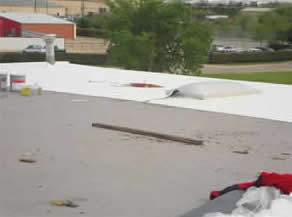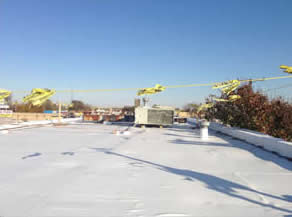Single Ply
MRB Contractors specializes in single ply commercial roofing systems. We install approximately 50,000 square feet of single ply systems per month and we work with some of the largest contractors in the state. MRB is a certified installer and provides its clients with a manufacturer’s warranty on every new roof system. We use high performance building materials and systems of proven capability to guarantee optimum roof performance. Every roof system we install is designed to meet custom specifications. All of our installation teams are OSHA compliant and undergo extensive classroom training to help ensure a safe work environment. All job sites are flagged off prior to the installation or removal process and our crews wear hardhats when necessary.
TPO
TPO stands for Thermoplastic PolyOlefin. TPO membranes are single-ply roof membranes constructed from ethylene propylene rubber. TPO is the fastest growing segment in the commercial roofing industry. TPO is designed to combine the durability of EPDM rubber with the proven performance of hot-air weldable seams. They have been tested as having excellent resistance to ozone, are algae-resistant, environmentally friendly and safe to install. The material’s manufacturers are so confident in properly welded seams that the material is sometimes advertised as a monolithic (seamless) roof. Seam strengths are reportedly 3 to 4 times those of EPDM’s adhesive and tape seams. TPO is highly resistant to tears, impacts, and punctures. It also has good flexibility to allow for building movement. TPO’s are available in white, light gray, and black with thicknesses of either 45 mils (.045″) or 60 mils (.060″). The width of the membrane depends on the manufacturer but they usually come in widths of six to six-and-a-half feet and are one-hundred feet in length.
PVC
PVC Installation Methods
- Fully Adhered -Fully adhered means that the roof is “glued” to the substrate using a special adhesive. What actually happens is the glue creates a chemical bond with the membrane.
- Mechanically Attached – Mechanically-attached membranes are those that use some type of special screw-type fastener to secure it. The type of fastener will depend on the type of substrate but all fasteners are generally screw-type fasteners.
- Ballasted – Ballasted simply means the membrane is loose laid over the top of the roof, sealed at all penetrations and around the perimeter, and then a ballast is put on it to hold it in place. Ballast usually consists of smooth, round, river rock 2″ – 3″ in diameter and is applied at a rate of 1,000 to 1,200 pounds per roof square (100 sq. ft.). Sometimes concrete pavers are used in their place. These average 20 pounds per square foot.



